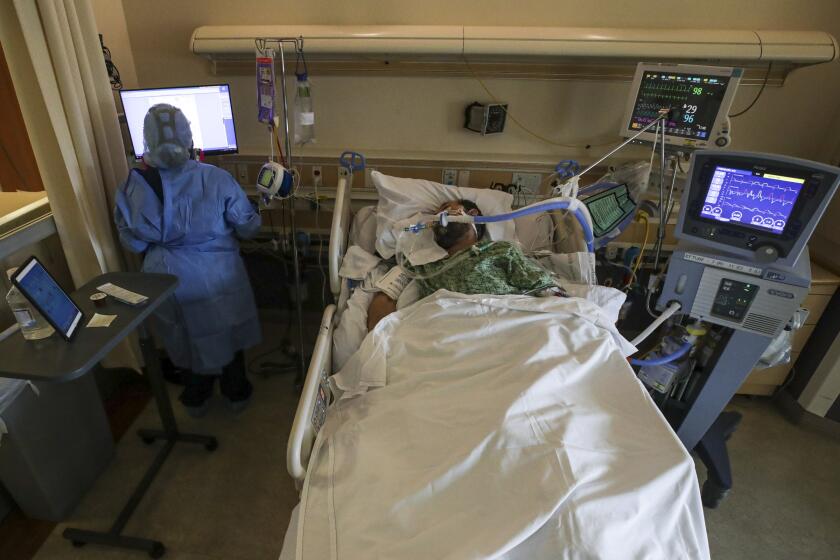Their fight to be understood
Martin Romoff used to rely on his voice to make a living as a Los Angeles tire salesman. But two decades of Parkinson’s disease muffled his speech and spoiled the art of easy conversation. Even his wife, Shirley, asked him to repeat himself over and over.
Then he learned about a special kind of voice training. For four one-hour sessions over a month, Romoff worked with a speech therapist in a program designed specifically to help people with Parkinson’s disease retain -- or reclaim -- the clarity of their speech.
Developers of the therapy, called the Lee Silverman Voice Treatment (also known as LSVT or LOUD), say that by making a healthy, intensive effort to speak more loudly, people with Parkinson’s disease can regain control of their speaking voices. Although the program is now administered in 30 countries, the neuromuscular mechanisms behind its effects are still unclear. Nor have there been state-of-the-art, double-blind controlled studies to test how well it works.
Now researchers are studying LSVT in a small clinical trial that could help pinpoint how the program’s simple drill profoundly affects the speech system.
Parkinson’s disease afflicts 500,000 to 1 million Americans, most of whom are diagnosed after age 65. The disorder involves the death of brain cells that produce the nerve chemical dopamine, which helps carry commands from the brain’s muscle-control centers.
People with Parkinson’s disease move slowly, and their arms and legs may be rigid and shaken by tremors. Less well known is that Parkinson’s can also take away patients’ normal voice because it strikes vocal cord muscles as well. Speech becomes slurred, and voices soft, hoarse or shaky.
The problem can be tremendously isolating. “One of my patients in New York would say to me, ‘If I have no voice, I have no life,’ ” says Lorraine Ramig, speech science professor at the University of Colorado at Boulder and one of LSVT’s developers.
Although up to nine out of 10 of people with Parkinson’s disease have speech and voice disorders (known collectively as dysarthria), only about 4% receive any type of speech therapy. Researchers have tried nonbehavioral approaches, such as implanting collagen into vocal cords and stimulating the brain with electrodes, but nothing has proved to have lasting success. In fact, some older types of brain stimulation have been shown to make dysarthria worse, not better, says Bruce Gerratt, professor of head and neck surgery at UCLA medical school.
The LSVT program, developed at the Lee Silverman Center for Parkinson’s Disease in Arizona, uses exercises that focus on a single, simple goal: producing a healthy, louder voice through extra effort.
“We tell people, ‘Speak louder than you think you need to,’ ” says Cynthia Fox, a researcher at the National Center for Voice and Speech in Denver and vice president of the LSVT Foundation.
The focus on volume is “deceptively simple, but you get a lot of bang for your buck,” says Geralyn Schulz, a speech science professor at George Washington University. “Even without a speech therapist telling you to open your mouth wider, or take a deeper breath, or move your tongue more, you automatically do those things when you speak loud.”
That is the opposite of what normally happens with Parkinson’s patients, who generally make short and small movements: Handwriting gets tiny, walking strides get shorter, and speech suffers from a lack of bigness .
Also crucial, Ramig believes, is concentrating on a single aspect of speech. This keep-it-simple approach is especially relevant for Parkinson’s patients, who often have memory and learning problems.
To explore whether volume is the key, or if other simple goals can also work, Ramig and colleagues are conducting a clinical trial in Denver. Healthy volunteers and Parkinson’s patients will undergo either LSVT training or a program that targets articulation instead. Researchers hope to enroll a total of 80 patients; results are expected next year.
Scientists also need to get a better sense of how well LSVT works. Although small studies have shown promising results, larger-scale multicenter clinical trials of the therapy are lacking, Ramig says. It’s also not clear what affects an individual’s success with the program, including factors such as the patient’s age, time since diagnosis, cognitive abilities and stage of disease.
Nor do therapists know how long the effects will last.
After Martin Romoff completed the LSVT program about three years ago, he and his wife noticed that his voice was stronger. “Speaking was easier, and people understood me better,” Romoff says.
The positive effects lasted for a while, he says, but his voice has since slipped back into old patterns.
To help Romoff and others like him, Ramig and her colleagues are experimenting with Web cams, software programs and other technology to help patients continue their practice.
*
Parkinson’s: A focus on big movements
Parkinson’s patients can learn to “speak loud,” but can they also learn to “move big”?
Researchers are experimenting with training patients to take big steps, make large gestures and generally exert a grand effort in all movements. The goal is to combat the characteristic slowness of Parkinson’s disease -- known as bradykinesia -- by encouraging them to crank up the drive to their muscles, says Becky Farley, a physiology professor at the University of Arizona and a developer of the program. As with the Lee Silverman Voice Treatment for voice control, patients focus on a single goal: bigness.
In a study of 29 Parkinson’s patients and healthy volunteers, the new therapy program improved some facets of patients’ movements. Their strides were longer and their torso rotated more freely, both immediately after therapy and three months later. And they could remember to take bigger steps even when their attention was diverted elsewhere, such as having to recite the days of the week backward.
Early-stage patients saw better results than those with more advanced Parkinson’s, especially in walking speed.
-- Regina Nuzzo



